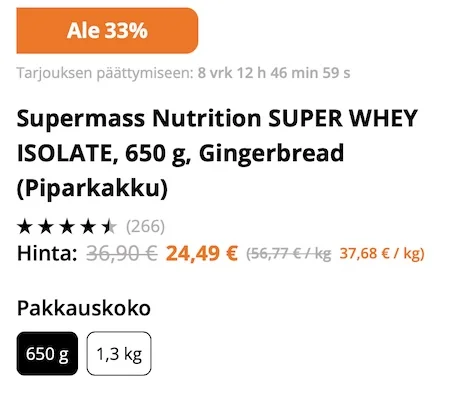- Liittynyt
- 7.5.2005
- Viestejä
- 1 224
Tykkäätkö syödä terveellisesti? Pidätkö listoista?
Nyt voit yhdistää nämä taipumuksesi. Tässä pari listaa ruoka-aineista, joita kannattaa mahduttaa ruokavalioonsa. Kun löydätte lisää, pankaa tulemaan.
TC Luoma T-Nationista:
Parsakaali
Merilohi
Luomuliha (grass-fed beef)
Saksanpähkinät
Oliiviöljy
Mustikka
Pellavansiemenet
Kurpitsa
Pinaatti
Tomaatti
Kalkkunanrinta
Jogurtti
Siitake-sienet
Sitten Mannisen välittämä Lucy Hoen lista:
Top 10 “Superfoods”
In her recent ”Health Telegraph” column, Lucy Hoe provided a list
of the top 10 health-boosting foods. Although this list is based on limited
scientific evidence, I tend to agree with Lucy:
Strawberries. Rich in disease-fighting antioxidants.
Blueberries. May help to reduce cholesterol and may also slow
down mental aging.
Oily fish. High levels of heart-healthy omega-3 fatty acids and
high-quality protein. Also improves inflammatory conditions, such as
arthritis. Walnuts. According to the FDA, “Research shows that eating one
and a half ounces of walnuts per day, as part of a diet low in saturated fat
and cholesterol, may reduce the risk of coronary heart disease."
Garlic. Protects the heart and may also help ward off the common
cold.
Mushrooms. Can help you avoid colds and other viruses.
Pineapples. The bromelain in pineapples acts as a potent
painkiller.
Broccoli. Contain substances that appear to act in the same way
as the drugs used to treat Alzheimer's disease.
Olive oil. Contains heart-healthy fatty acids and a compound with
the same pain-relieving effects as the popular over-the-counter drug
ibuprofen.
Tomatoes. One of the richest sources of the potent antioxidant
lycopene, which may lower the risk of prostate cancer and cardiovascular
disease.
Lisänumerona omalla listallani olisi vielä:
Kananmuna
Maksa
Nyt voit yhdistää nämä taipumuksesi. Tässä pari listaa ruoka-aineista, joita kannattaa mahduttaa ruokavalioonsa. Kun löydätte lisää, pankaa tulemaan.
TC Luoma T-Nationista:
Parsakaali
Merilohi
Luomuliha (grass-fed beef)
Saksanpähkinät
Oliiviöljy
Mustikka
Pellavansiemenet
Kurpitsa
Pinaatti
Tomaatti
Kalkkunanrinta
Jogurtti
Siitake-sienet
Sitten Mannisen välittämä Lucy Hoen lista:
Top 10 “Superfoods”
In her recent ”Health Telegraph” column, Lucy Hoe provided a list
of the top 10 health-boosting foods. Although this list is based on limited
scientific evidence, I tend to agree with Lucy:
Strawberries. Rich in disease-fighting antioxidants.
Blueberries. May help to reduce cholesterol and may also slow
down mental aging.
Oily fish. High levels of heart-healthy omega-3 fatty acids and
high-quality protein. Also improves inflammatory conditions, such as
arthritis. Walnuts. According to the FDA, “Research shows that eating one
and a half ounces of walnuts per day, as part of a diet low in saturated fat
and cholesterol, may reduce the risk of coronary heart disease."
Garlic. Protects the heart and may also help ward off the common
cold.
Mushrooms. Can help you avoid colds and other viruses.
Pineapples. The bromelain in pineapples acts as a potent
painkiller.
Broccoli. Contain substances that appear to act in the same way
as the drugs used to treat Alzheimer's disease.
Olive oil. Contains heart-healthy fatty acids and a compound with
the same pain-relieving effects as the popular over-the-counter drug
ibuprofen.
Tomatoes. One of the richest sources of the potent antioxidant
lycopene, which may lower the risk of prostate cancer and cardiovascular
disease.
Lisänumerona omalla listallani olisi vielä:
Kananmuna
Maksa








